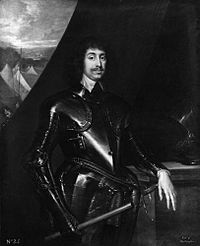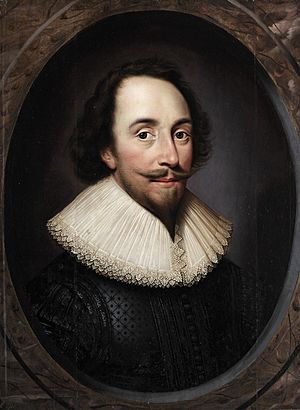Spencer Compton, 2nd Earl of Northampton facts for kids
Spencer Compton, 2nd Earl of Northampton (born May 1601 – died March 19, 1643), was an English soldier and politician. He was known as Lord Compton from 1618 to 1630. He served in the House of Commons from 1621 to 1622. He became a peer (a noble) in 1626 and inherited his father's title in 1630. He fought bravely for the King's side (the Royalists) during the English Civil War and was killed in action at the Battle of Hopton Heath.
Early Life and Political Roles
Spencer Compton was born in 1601. His father was William Compton, 1st Earl of Northampton, and his mother was Elizabeth. In 1616, he was made a Knight of the Bath.
In 1621, he was chosen to be a Member of Parliament for Ludlow. That same year, he became the Master of the Robes for the Prince of Wales (who later became King Charles I). He even went with the Prince on a trip to Spain in 1623.
Spencer Compton strongly supported the King. In 1626, he became Baron Compton. Then, in 1630, when his father passed away, he inherited the title of Earl of Northampton. He also took on important jobs as Lord Lieutenant of Gloucestershire and Lord Lieutenant of Warwickshire, which meant he was the King's main representative in those areas.
Fighting in the Civil War

When the English Civil War began, Spencer Compton was put in charge of gathering soldiers for the King in Warwickshire. He fought in different battles across the English Midlands. He was part of the Battle of Edgehill, an important early battle of the war.
After King Charles I of England returned to Oxford, Spencer Compton was given control of the military in Banbury and the nearby areas in November 1642. Parliamentary forces attacked him in Banbury on December 22, but Prince Rupert of the Rhine came to his rescue the next day.
In March 1643, he marched from Banbury to try and help Lichfield, but he wasn't successful there. He then went to Stafford and took control of it. On March 19, he led his troops, along with three of his sons, to fight against Sir John Gell, 1st Baronet and Sir William Brereton at the Battle of Hopton Heath.
During the battle, he bravely defeated the enemy's cavalry (horse soldiers) and captured eight cannons. However, in the excitement of victory, he charged too far ahead and was surrounded by the Parliamentarian soldiers. When they offered him a chance to surrender, he refused, saying he would not surrender to "rebels." He was then killed by a blow to the head. His death was seen as a great loss for the King's side.
Family Life
Spencer Compton married Mary, the daughter of Sir Francis Beaumont. Spencer and Mary had two daughters and six sons. Four of their eldest sons also fought as Cavaliers for the King during the Civil War, often fighting together.
- James (1622–1681) became the 3rd Earl of Northampton after his father's death.
- Charles (around 1624–1661) was a Member of Parliament for Northampton.
- William (around 1625–1663) was one of the first members of a Royalist group called The Sealed Knot.
- Spencer (around 1629–1659) was knighted in 1643.
- Francis (around 1629–1716) was a Member of Parliament for Warwick.
- Henry (1632–1713) became the bishop of London.
- Anne married Sir Hugh Cholmeley, 4th Baronet.
- Penelope married Sir John Nicholas.
Mary, Countess of Northampton, passed away on March 18, 1654, in London.


